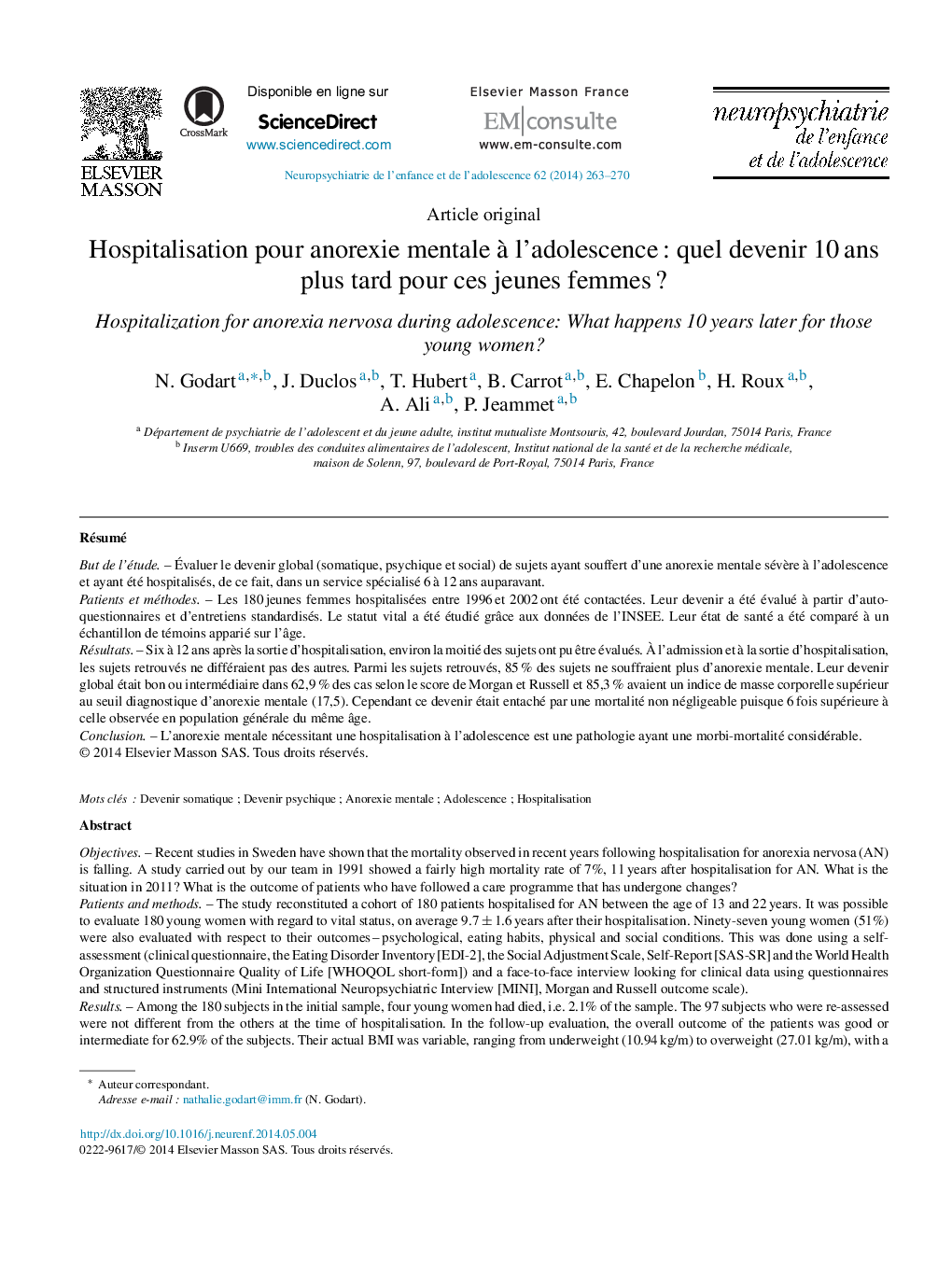| کد مقاله | کد نشریه | سال انتشار | مقاله انگلیسی | نسخه تمام متن |
|---|---|---|---|---|
| 943768 | 925558 | 2014 | 8 صفحه PDF | دانلود رایگان |

RésuméBut de l’étudeÉvaluer le devenir global (somatique, psychique et social) de sujets ayant souffert d’une anorexie mentale sévère à l’adolescence et ayant été hospitalisés, de ce fait, dans un service spécialisé 6 à 12 ans auparavant.Patients et méthodesLes 180 jeunes femmes hospitalisées entre 1996 et 2002 ont été contactées. Leur devenir a été évalué à partir d’auto-questionnaires et d’entretiens standardisés. Le statut vital a été étudié grâce aux données de l’INSEE. Leur état de santé a été comparé à un échantillon de témoins apparié sur l’âge.RésultatsSix à 12 ans après la sortie d’hospitalisation, environ la moitié des sujets ont pu être évalués. À l’admission et à la sortie d’hospitalisation, les sujets retrouvés ne différaient pas des autres. Parmi les sujets retrouvés, 85 % des sujets ne souffraient plus d’anorexie mentale. Leur devenir global était bon ou intermédiaire dans 62,9 % des cas selon le score de Morgan et Russell et 85,3 % avaient un indice de masse corporelle supérieur au seuil diagnostique d’anorexie mentale (17,5). Cependant ce devenir était entaché par une mortalité non négligeable puisque 6 fois supérieure à celle observée en population générale du même âge.ConclusionL’anorexie mentale nécessitant une hospitalisation à l’adolescence est une pathologie ayant une morbi-mortalité considérable.
ObjectivesRecent studies in Sweden have shown that the mortality observed in recent years following hospitalisation for anorexia nervosa (AN) is falling. A study carried out by our team in 1991 showed a fairly high mortality rate of 7%, 11 years after hospitalisation for AN. What is the situation in 2011? What is the outcome of patients who have followed a care programme that has undergone changes?Patients and methodsThe study reconstituted a cohort of 180 patients hospitalised for AN between the age of 13 and 22 years. It was possible to evaluate 180 young women with regard to vital status, on average 9.7 ± 1.6 years after their hospitalisation. Ninety-seven young women (51%) were also evaluated with respect to their outcomes – psychological, eating habits, physical and social conditions. This was done using a self-assessment (clinical questionnaire, the Eating Disorder Inventory [EDI-2], the Social Adjustment Scale, Self-Report [SAS-SR] and the World Health Organization Questionnaire Quality of Life [WHOQOL short-form]) and a face-to-face interview looking for clinical data using questionnaires and structured instruments (Mini International Neuropsychiatric Interview [MINI], Morgan and Russell outcome scale).ResultsAmong the 180 subjects in the initial sample, four young women had died, i.e. 2.1% of the sample. The 97 subjects who were re-assessed were not different from the others at the time of hospitalisation. In the follow-up evaluation, the overall outcome of the patients was good or intermediate for 62.9% of the subjects. Their actual BMI was variable, ranging from underweight (10.94 kg/m) to overweight (27.01 kg/m), with a mean of 19.38 ± 2.71 kg/m. BMI was above the AN threshold for 85.3% of cases, and menstruation was present in about the same proportion. The mean score on the EDI-2 was fairly good, although it was 10 points above the mean score for the general population (54.94 ± 40.05) compared to 44 in the general population; this is nevertheless well above the mean for an anorexic population, which is 106. Only 15.5% of the subjects (n = 15) were still suffering from AN or bulimia (BN) according to complete DSM-IV criteria. Four were AN-R, and 11 were alternating from AN to BN. Social adjustment was good on average (mean score of 1.74 ± 0.43 on SAS-SR scale) as was their quality of life (mean score 67.05 ± 18.37 on the WHOQOL short form). The mortality of our sample was six times over the rate observed in general population.ConclusionAN that requires hospitalization during adolescence is a high morbi-mortality pathology.
Journal: Neuropsychiatrie de l'Enfance et de l'Adolescence - Volume 62, Issue 5, September 2014, Pages 263–270